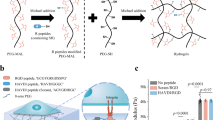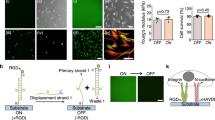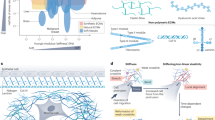Abstract
Stem cells sense and respond to the mechanical properties of the extracellular matrix. However, both the extent to which extracellular-matrix mechanics affect stem-cell fate in three-dimensional microenvironments and the underlying biophysical mechanisms are unclear. We demonstrate that the commitment of mesenchymal stem-cell populations changes in response to the rigidity of three-dimensional microenvironments, with osteogenesis occurring predominantly at 11–30 kPa. In contrast to previous two-dimensional work, however, cell fate was not correlated with morphology. Instead, matrix stiffness regulated integrin binding as well as reorganization of adhesion ligands on the nanoscale, both of which were traction dependent and correlated with osteogenic commitment of mesenchymal stem-cell populations. These findings suggest that cells interpret changes in the physical properties of adhesion substrates as changes in adhesion-ligand presentation, and that cells themselves can be harnessed as tools to mechanically process materials into structures that feed back to manipulate their fate.
This is a preview of subscription content, access via your institution
Access options
Subscribe to this journal
Receive 12 print issues and online access
$259.00 per year
only $21.58 per issue
Buy this article
- Purchase on Springer Link
- Instant access to full article PDF
Prices may be subject to local taxes which are calculated during checkout






Similar content being viewed by others
References
Passier, R., van Laake, L. W. & Mummery, C. L. Stem-cell based therapy and lessons from the heart. Nature 453, 322–329 (2008).
Silva, E. A., Kim, E. S., Kong, H. J. & Mooney, D. J. Material-based deployment enhances efficacy of endothelial progenitor cells. Proc. Natl Acad. Sci. USA 105, 14347–14352 (2008).
Ali, O. A., Huebsch, N., Cao, L., Dranoff, G. & Mooney, D. J. Infection-mimicking materials to program dendritic cells in situ. Nature Mater. 8, 151–158 (2009).
Hynes, R. O. Integrins: Bidirectional, allosteric signalling machines. Cell 110, 673–687 (2002).
Geiger, B. & Bershadsky, A. Exploring the neighbourhood: Adhesion-coupled mechanosensors. Cell 110, 139–142 (2002).
Alsberg, E., Anderson, K. W., Albeiruti, A., Rowley, J. A. & Mooney, D. J. Engineering growing tissues. Proc. Natl Acad. Sci. USA 99, 12025–12030 (2002).
Yang, F. et al. The effect of incorporating RGD adhesive peptide in polyethylene glycol diacrylate hydrogel on osteogenesis of bone marrow stromal cells. Biomaterials 26, 5991–5998 (2005).
Burdick, J. A. & Anseth, K. S. Photoencapsulation of osteoblasts in injectable RGD-modified PEG hydrogels for bone tissue engineering. Biomaterials 32, 4315–4323 (2002).
Klees, R. F. et al. Laminin-5 induces osteogenic gene expression in human mesenchymal stem cells through an ERK-dependent pathway. Mol. Biol. Cell 16, 881–890 (2005).
Engler, A. J., Sen, S., Sweeny, H. L. & Discher, D. E. Matrix elasticity directs stem cell lineage specification. Cell 126, 677–689 (2006).
Kong, H. J., Polte, T. R., Alsberg, E. & Mooney, D. J. FRET measurements of cell-traction forces and nano-scale clustering of adhesion ligands varied by substrate stiffness. Proc. Natl Acad. Sci. USA 102, 4300–4305 (2005).
Cukierman, E., Pankov, R., Stevens, D. R. & Yamada, K. M. Taking cell-matrix adhesions to the third dimension. Science 294, 1708–1712 (2001).
Fischbach, C. et al. Cancer cell angiogenic capability is regulated by 3-D culture and integrin engagement. Proc. Natl Acad. Sci. USA 106, 399–404 (2009).
Griffith, L. G. & Swartz, M. A. Capturing complex 3D tissue physiology in vitro. Nature Rev. Mol. Cell Biol. 7, 211–224 (2006).
Hsiong, S. X., Boontheekul, T., Huebsch, N. & Mooney, D. J. Cyclic RGD peptides enhance 3D stem cell osteogenic differentiation. Tissue Eng. A 15, 263–272 (2009).
Diduch, D. R., Coe, M. R., Joyner, C., Owen, M. E. & Balian, G. Two cell lines from bone marrow that differ in terms of collagen synthesis, osteogenic characteristics, and matrix mineralization. J. Bone Joint Surg. Am. 75, 92–105 (1993).
Rowley, J. A., Madlambayan, G. & Mooney, D. J. Alginate hydrogels as synthetic extracellular matrix materials. Biomaterials 20, 45–53 (1999).
Alsberg, E. et al. Regulating bone formation via controlled scaffold degradation. J. Dent. Res. 80, 2025–2029 (2001).
Lutolf, M. P. et al. Repair of bone defects using synthetic mimetics of collagenous extracellular matrices. Nature Biotechnol. 21, 513–518 (2003).
Connelly, J. T., Garcia, A. J. & Levenston, M. E. Interactions between integrin ligand density and cytoskeletal integrity regulate BMSC chondrogenesis. J. Cell. Physiol. 217, 145–154 (2008).
Bencherif, S. A. et al. Influence of the degree of methacrylation on hyaluronic acid hydrogels properties. Biomaterials 29, 1739–1749 (2008).
Pek, Y. S., Wan, A. C. A. & Ying, J. Y. The effect of matrix stiffness on mesenchymal stem cell differentiation in a 3D thioxtropic gel. Biomaterials 31, 385–391 (2010).
Ghajar, C. M. et al. The effect of matrix density on the regulation of 3-D capillary morphogenesis. Biophys. J. 94, 1930–1941 (2008).
Pelham, R. J. Jr & Wang, Y. L. Cell locomotion and focal adhesions are regulated by substrate flexibility. Proc. Natl Acad. Sci. USA 94, 13661–13665 (1997).
Jiang, G., Huang, A. H., Cai, Y., Tanase, M. & Sheetz, M. P. Rigidity sensing at the leading edge through αVβ3 integrins and RPTPα. Biophys. J. 90, 1804–1809 (2006).
McBeath, R., Pirone, D. M., Nelson, C. M., Bhadriraju, K. & Chen, C. S. Cell shape, cytoskeletal tension, and RhoA regulate stem cell lineage commitment. Dev. Cell 6, 483–495 (2004).
Benoit, D. S., Schwartz, M. P., Durney, A. R. & Anseth, K. S. Small functional groups for controlled differentiation of hydrogel-encapsulated human mesenchymal stem cells. Nature Mater. 7, 816–823 (2008).
Thomas, C. H., Collier, J. H., Sfeir, C. S. & Healy, K. E. Engineering gene expression and protein synthesis by modulation of nuclear shape. Proc. Natl Acad. Sci. USA 99, 1972–1977 (2002).
Discher, D. E., Janmey, P. & Wang, Y. L. Tissue cells feel and respond to the stiffness of their substrate. Science 310, 1139–1143 (2005).
Ingber, D. E. Cellular mechanotransduction: Putting all the pieces together again. FASEB J. 20, 811–827 (2006).
del Rio, A. et al. Stretching single talin rod molecules activates vinculin binding. Science 323, 638–641 (2009).
Baneyx, G., Baugh, L. & Vogel, V. Fibronectin extension and unfolding within cell matrix fibrils controlled by cytoskeletal tension. Proc. Natl Acad. Sci. USA 99, 5139–5143 (2002).
Johnson, C. P., Tang, H. Y., Carag, C., Speicher, D. W. & Discher, D. E. Forced unfolding of proteins within cells. Science 317, 663–666 (2007).
Chung, E. H. et al. Biomimetic artificial ECMs stimulate bone regeneration. J. Biomed. Mater. Res. A 79, 815–826 (2006).
Engler, A. J. et al. Substrate compliance versus ligand density in cell on gel responses. Biophys. J. 86, 617–628 (2004).
Bell, G. I. Models for the specific adhesion of cells to cells. Science 200, 618–627 (1978).
Dembo, M., Torney, D. C., Saxman, K. & Hammer, D. The reaction-limited kinetics of membrane-to-surface adhesion and detachment. Proc. R. Soc. Lond. B 234, 55–83 (1988).
Marshall, B. T. et al. Direct observation of catch bonds involving cell-adhesion molecules. Nature 423, 190–193 (2003).
Kong, F., Garcia, A. J., Mould, A. P., Humphries, M. J. & Zhu, C. Demonstration of catch bonds between an integrin and its ligand. J. Cell Biol. 185, 1275–1284 (2009).
Aota, S., Nomizu, M. & Yamada, K. M. The short amino acid sequence Pro–His–Ser–Arg–Asn in human fibronectin enhances cell-adhesive function. J. Biol. Chem. 269, 24756–24761 (1994).
Kong, H. J., Boontheekul, T. & Mooney, D. J. Quantifying the relation between ligand–receptor bond formation and cell phenotype. Proc. Natl Acad. Sci. USA 103, 18534–18539 (2006).
Lakowicz, J. T. Principles of Fluorescence Spectroscopy 3rd edn (Springer, 2006).
Huebsch, N. D. & Mooney, D. J. Fluorescent resonance energy transfer: A tool for probing molecular cell–biomaterial interactions in three dimensions. Biomaterials 28, 2424–2437 (2007).
Hern, D. L. & Hubbell, J. A. Incorporation of adhesion peptides into nonadhesive hydrogels useful for tissue resurfacing. J. Biomed. Mater. Res. 32, 266–276 (1998).
Galbraith, C. G., Yamada, K. M. & Sheetz, M. P. The relationship between force and focal complex development. J. Cell Biol. 159, 695–705 (2002).
Danen, E. H. et al. Requirement for the synergy site for cell adhesion to fibronectin depends on the activation state of integrin α5β1 . J. Biol. Chem. 270, 21612–21618 (1995).
Friedland, J. C., Lee, M. H. & Boettiger, D. Mechanically activated integrin switch controls α5β1 function. Science 323, 642–644 (2009).
Galbraith, C. G., Yamada, K. M. & Galbraith, J. A. Polymerizing actin fibers position integrins primed to probe for adhesion sites. Science 315, 992–995 (2007).
Brown, C. M. et al. Probing the integrin–actin linkage using high-resolution protein velocity mapping. J. Cell Sci. 119, 5204–5214 (2006).
Ward, M. D. & Dembo, M. Kinetics of cell detachment: Peeling of discrete receptor clusters. Biophys. J. 67, 2522–2534 (1994).
Keselowsky, B. G., Collard, D. M. & Garcia, A. J. Integrin binding specificity regulates biomaterial surface chemistry effects on cell differentiation. Proc. Natl Acad. Sci. USA 102, 5953–5957 (2005).
Lai, C. F. & Cheng, S. L. αvβ integrins play an essential role in BMP-2 induction of osteoblast differentiation. J. Bone Miner. Res. 20, 330–340 (2005).
Acknowledgements
We thank R. F. Horwitz for providing the human α5-integrin–enhanced GFP plasmid, and B. Tilton for carrying out FACs sorting of GFP-expressing mMSCs at the Harvard FAS Center for Systems Biology. We also thank E. Gatzogiannis for assisting with confocal microscopy at the Harvard University Center for Nanoscale Systems (CNS). The monoclonal antibody against osteopontin (MPIIIB101) developed by M. Solursh and A. Franzen was obtained from the Developmental Studies Hybridoma Bank developed under the auspices of the NICHD and maintained by the University of Iowa, Department of Biology, Iowa City, IA. We acknowledge R. Schmidt and K. E. Healy (University of California, Berkeley) for advice regarding nuclear morphology measurements, A. Putnam (University of Michigan), H. J. Kong, C. Fischbach and S. Hsiong for discussions, and H. Vandenburgh (Brown University) and Z. Suo for critical reading of the manuscript. We also acknowledge funding from NIH (R37 DE013033) and from the NIH ‘Systems-Based Consortium for Organ Design and Engineering’ training grant (J.R-F., 1TL1EB008540-01, NIBIB), a Harvard Presidential Fellowship (P.R.A.), an NSF Graduate Research Fellowship (N.H.), the Harvard College Research Program (A.S.M.), an EMBO Long-Term Fellowship ALTF 42-2008 (D.S.) and the Wyss Institute for Biologically Inspired Engineering (S.A.B.).
Author information
Authors and Affiliations
Contributions
The experiments were designed by N.H., P.R.A. and D.J.M. and carried out by N.H., P.R.A., A.S.M., D.S. and O.A.A. N.H., S.A.B. and J.R-F. provided new reagents/analytical tools. The manuscript was written by N.H. and D.J.M. The principal investigator is D.J.M.
Corresponding author
Ethics declarations
Competing interests
The authors declare no competing financial interests.
Supplementary information
Supplementary Information
Supplementary Information (PDF 1055 kb)
Rights and permissions
About this article
Cite this article
Huebsch, N., Arany, P., Mao, A. et al. Harnessing traction-mediated manipulation of the cell/matrix interface to control stem-cell fate. Nature Mater 9, 518–526 (2010). https://doi.org/10.1038/nmat2732
Received:
Accepted:
Published:
Issue Date:
DOI: https://doi.org/10.1038/nmat2732
This article is cited by
-
Injectable ultrasound-powered bone-adhesive nanocomposite hydrogel for electrically accelerated irregular bone defect healing
Journal of Nanobiotechnology (2024)
-
A xonotlite nanofiber bioactive 3D-printed hydrogel scaffold based on osteo-/angiogenesis and osteoimmune microenvironment remodeling accelerates vascularized bone regeneration
Journal of Nanobiotechnology (2024)
-
Neurogenic Cell Behavior in 3D Culture Enhanced Within a Highly Compliant Synthetic Hydrogel Platform Formed via Competitive Crosslinking
Cellular and Molecular Bioengineering (2024)
-
Adhesive hydrogels in osteoarthritis: from design to application
Military Medical Research (2023)
-
Therapeutic angiogenesis and tissue revascularization in ischemic vascular disease
Journal of Biological Engineering (2023)



